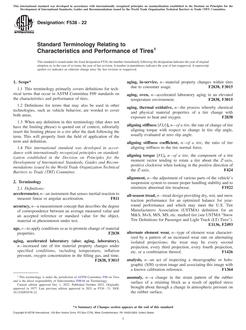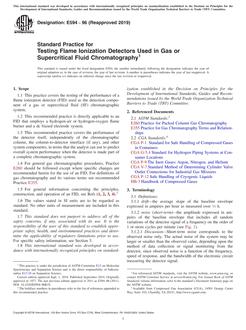1.1 This practice is for general use in gathering and reporting dynamic mechanical data. It incorporates laboratory practice for determining dynamic mechanical properties of plastic specimens subjected to various oscillatory deformations on a variety of instruments of the type commonly called dynamic mechanical analyzers or dynamic thermomechanical analyzers.
1.2 This practice is intended to provide means of determining the transition temperatures, elastic, and loss moduli of plastics over a range of temperatures, frequencies, or time, by free vibration and resonant or nonresonant forced vibration techniques. Plots of elastic and loss moduli are indicative of the viscoelastic characteristics of a plastic. These moduli are functions of temperature or frequency in plastics, and change rapidly at particular temperatures or frequencies. The regions of rapid moduli change are normally referred to as transition regions.
1.3 The practice is primarily useful when conducted over a range of temperatures from 160C to polymer degradation and is valid for frequencies from 0.01 to 1000 Hz.
1.4 This practice is intended for materials that have an elastic modulus in the range from 0.5 MPa to 100 GPa [73 psi to 1.5 10 7 psi].
1.5 Discrepancies in results are known to arise when obtained under differing experimental conditions. Without changing the observed data, reporting in full (as described in this practice) the conditions under which the data were obtained will enable apparent differences observed in another study to be reconciled. An assumption of this technique is that testing is conducted in the region of linear viscoelastic behavior.
1.6 Different modes of deformation, such as tensile, bending and shear, are used, as listed in the referenced test methods.
1.7 Test data obtained by this practice are relevant and appropriate for use in engineering design.
1.8 The values stated in SI units are to be regarded as standard. The values given in brackets are for information only.
This standard does not purport to address all of the safety concerns, if any, associated with its use. It is the responsibility of the user of this practice to establish appropriate safety and health practices and determine the applicability of regulatory limitations prior to use.
Note 1
This practice is equivalent to ISO 6721-1.
Product Details
- Published:
- 12/01/2006
- Number of Pages:
- 7
- File Size:
- 1 file , 110 KB
- Redline File Size:
- 2 files , 210 KB


